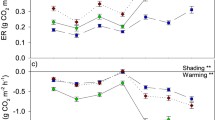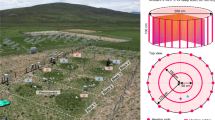Abstract
There is increasing evidence of climate change in Antarctica, especially elevated temperature and ultraviolet B (UVB) flux within the ozone “hole.” Its origins are debatable, but the effects on ice recession, water availability, and summer growth conditions are demonstrable. Light-dependent, temperature-sensitive, fast-growing organisms respond to these physical and biogeographical changes. Microalgae (cyanobacteria and eukaryotic algae), which are pioneer colonists of Antarctic mineral fellfield soils, are therefore highly suitable biological indicators of such changes. In frost-heaved soil polygons containing naturally sorted fine mineral particles, microalgal growth is restricted to a shallow zone of light penetration. By virtue of this light requirement, microalgae are exposed to extreme seasonal fluctuations in temperature (air and black-body radiation), photosynthetically active radiation, UV radiation, and desiccation. Dominance of conspicuous autofluorescent indicator species with distinctive morphology allowed quantification of responses using epifluorescence microscopy, and image analysis of undisturbed, unstained communities. However, the physical changes in climate, although significant in the long term, are gradual. The changes were therefore amplified experimentally by enclosing the communities at a fellfield site on Signy Island, maritime Antarctica, in cloches (small greenhouses). These were made of polystyrene of either UV transparent or UV opaque acrylic plastic, with or without walls. During a 6-year period, statistically significant changes were observed in microalgal colonization of the soil surface and in the morphology of filamentous populations. Evidence of community succession correlated with measured changes in local environment was found. Results from Signy Island and at continental sites on Alexander Island suggested that rates of microalgal colonization and community development might change significantly during current climate changes in Antarctica.
Similar content being viewed by others
References
Ambrose WR (1984) Soil temperature monitoring at Lake Mungo. Austral Archaeol 18:64–74
Broady PA (1979) The terrestrial algae of Signy Island, South Orkney Islands. Br Antarct Surv Sci Rep 98:1–117
Broady PA, Garrick R, Anderson G (1984) Culture studies on the morphology of ten strains of Antarctic Oscillatoriaceae (Cyanobacteria). Polar Biol 2:233–244
Broady PA, Smith R (1991) An initial report on an investigation of the dispersal of algae in southern Victoria Land. BIOTAS Newsletter No 6:5–7 and Erratum, BIOTAS Newsletter 7:10
Broady PA, Smith RA (1994) A preliminary investigation of the diversity, survivability and dispersal of algae introduced into Antarctica by human activity. Proc NIPR Symp Polar Biol 7:185–197
Davey MC (1989) The effects of freezing and desiccation on photosynthesis and survival of terrestrial algae and cyanobacteria. Polar Biol 10:29–36
Davey MC (1991) The seasonal periodicity of algae on Antarctic fellfield soils. Holarct Ecol 14:112–120
Davey MC, Clarke KJ (1991) The spatial distribution of microalgae on Antarctic fellfield soils. Antarct Sci 3:257–263
Davey MC, Rothery P (1992) Factors causing limitation of growth of terrestrial algae in maritime Antarctica during late summer. Polar Biol 12:595–601
Davey MC, Rothery P (1993) Primary colonization by microalgae in relation to spatial variation in edaphic factors on Antarctic fellfield soils. J Ecol 81:335–343
Davey MC, Pickup J, Block W (1992) Temperature variation and its biological significance in fellfield habitats on a maritime Antarctic Island. Antarct Sci 4:383–388
Kennedy AD (1993) Water as a limiting factor in the Antarctic terrestrial environment: a biogeographical synthesis. Arct Alpine Res 25:308–315
Kennedy AD (1995) Simulated climate change: are passive greenhouses a valid microcosm for testing the effects of environmental perturbations? Global Change Res 1:29–42
Kennedy AD (1995) Temperature effects of passive greenhouse apparatus in high latitude climate change experiments. Functional Ecol 9:340–350
Lewis Smith RI (1988) Bryophyte oases in ablation valleys on Alexander Island, Antarctica. Bryologist 91:45–50
Madronich S (1992) Implications of recent total atmospheric ozone measurements for biologically active ultraviolet radiation reaching the earth's surface. Geophys Res Lett 19:37–40
Rodriguez H, Rivas J, Guerrero MG, Losada M (1989) Nitrogen-fixing cyanobacterium with a high phycoerythrin content. Appl Environ Microbiol 55:758–760
Weller GE (ed) (1993) The role of the Antarctic in global change: an international plan for a regional research programme. Scientific Committee on Antarctic Research, Cambridge, England
Wharton R, Dana G, Fountain A, Freckman D, Hastings J, Lyons WB, McKnight D, Moorhead D, Priscu J, Tate C (1994) McMurdo Dry Valleys Long-term Ecological Research site. In: Antarctic communities: species structure and survival, SCAR 6th Biology Symposium, Venice 30 May to 3 June, 1994, Abstracts Volume SCAR, Venice, p 292
World Meteorological Organization (1988) World Climate Programme. Developing Policies for Responding to Climatic Change (CWMO/TD Report No 225), Geneva, World Meteorological Organization
Wynn-Williams DD (1988) Television image analysis of microbial communities in Antarctic fellfields. Polarforschung 58:239–250
Wynn-Williams DD (1990) Microbial colonization processes in Antarctic fellfield soils—an experimental overview. Proc NIPR Symp Pol Biol 3:164–178
Wynn-Williams DD (1990) The application of image analysis to natural terrestrial ecosystems. Binary 2:15–20
Wynn-Williams DD (1992) Epifluorescence image analysis of the 3D structure of phototrophic microbial biofilms at Antarctic soil surfaces. Binary 4:53–57
Wynn-Williams DD (1992) Plastic cloches for manipulating natural terrestrial environments. In: Wynn-Williams DD (ed) BIOTAS manual of methods for Antarctic terrestrial and freshwater research 1–3. SCAR, Cambridge, England
Wynn-Williams DD (1993) Microbial processes and initial stabilization of fellfield. In: Miles J, Walton DWH (eds) Primary succession on land. Spec Publ Br Ecol Soc No. 12:17–32, Blackwell Scientific, Oxford, England
Wynn-Williams DD (1993) Is there life on Mars (Glacier)? NERC News 26:24–25
Wynn-Williams DD (1994) Potential effects of ultraviolet radiation on Antarctic primary terrestrial colonizers: cyanobacteria, algae and cryptogams. In: Weiler CS, Penhale PA (eds) Ultraviolet radiation in Antarctica: measurements and biological effects. Antarctic Research Series Vol. 62:243–257 Washington, DC, American Geophysical Union
Author information
Authors and Affiliations
Additional information
Correspondence to: D.D. Wynn-Williams.
Rights and permissions
About this article
Cite this article
Wynn-Williams, D.D. Response of pioneer soil microalgal colonists to environmental change in Antarctica. Microb Ecol 31, 177–188 (1996). https://doi.org/10.1007/BF00167863
Received:
Revised:
Published:
Issue Date:
DOI: https://doi.org/10.1007/BF00167863




